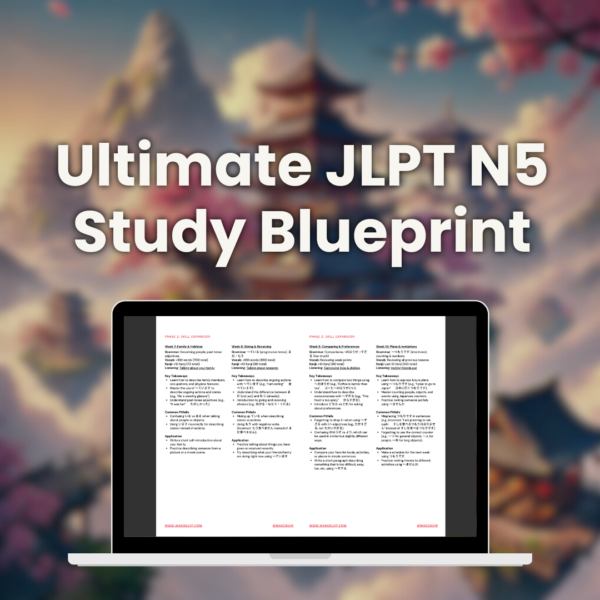Are you feeling overwhelmed by the prospect of taking the JLPT N5 exam? You’re not alone. The journey to Japanese language certification begins with proper JLPT N5 exam preparation, and having a clear roadmap can make all the difference between confusion and confidence.
As someone who has guided hundreds of students through successful JLPT N5 exam preparation, I’ve witnessed the common struggles and triumphs along this path. In this comprehensive guide, I’ll share the structured approach that has helped my students achieve certification without the overwhelm that so often accompanies Japanese language learning.
Understanding the JLPT N5 Exam Structure
Before diving into specific preparation strategies, it’s essential to understand what you’re preparing for. The JLPT N5 is the entry-level test in the Japanese Language Proficiency Test series, designed to measure your basic Japanese language competency.
What Does the JLPT N5 Test?
The JLPT N5 exam consists of three main sections:
- Language Knowledge (文字・語彙・文法) – 120 points
- Vocabulary (語彙)
- Grammar (文法)
- Reading (読解)
- Listening (聴解) – 60 points
- Understanding basic conversations
- Following simple instructions
- Comprehending short announcements
The total exam duration is approximately 105 minutes, and you’ll need a minimum of 80 points to pass, with at least 38 points in the Language Knowledge section and 19 points in Listening.
Required Knowledge Level
To successfully pass the JLPT N5, you should be familiar with:
- Writing Systems: Complete mastery of hiragana and katakana
- Kanji: Recognition of approximately 100 basic kanji
- Vocabulary: About 800 essential words for daily life
- Grammar: Basic sentence structures and particles
- Listening: Understanding slow, clear Japanese conversations
The 16-Week JLPT N5 Exam Preparation Strategy
Effective JLPT N5 exam preparation isn’t about cramming; it’s about consistent, structured practice. Here’s a proven 16-week roadmap that breaks down the journey into manageable phases:
Phase 1: Foundation Building (Weeks 1-6)
The first six weeks focus on establishing a solid foundation in Japanese fundamentals:
Weeks 1-2: Writing Systems & Basic Expressions
- Focus on: Mastering hiragana and katakana completely
- Grammar points: Basic sentence structure (AはBです), particles は, が, の
- Vocabulary development: 100-200 essential words
- Practice activity: Writing simple self-introductions using the patterns learned
During this initial phase, consistent daily practice is crucial. Even 15-20 minutes of hiragana/katakana writing practice can dramatically accelerate your memorization.
Weeks 3-4: Basic Verb Forms & Daily Expressions
- Focus on: Mastering basic verb forms (-masu, -masen, -mashita)
- Grammar points: Time expressions, location particles に/で
- Vocabulary expansion: Action verbs, time words, location terms
- Practice activity: Creating a Japanese diary with simple daily activities
A useful approach during this period is to maintain a simple Japanese journal using the patterns you’re learning. For example:
今日は学校に行きました。(Kyou wa gakkou ni ikimashita.) – Today I went to school.
友達とコーヒーを飲みました。(Tomodachi to koohii o nomimashita.) – I drank coffee with my friend.
Weeks 5-6: Descriptions & Basic Requests
- Focus on: Adjectives (い-adjectives and な-adjectives)
- Grammar points: て-form basics, making simple requests
- Vocabulary focus: Descriptive words, emotion terms
- Practice activity: Describing people, places, and making polite requests
As I covered in my article on Japanese Grammar Lessons, understanding the difference between い-adjectives and な-adjectives is crucial for proper sentence construction. Practice forming sentences like:
この本は面白いです。(Kono hon wa omoshiroi desu.) – This book is interesting.
田中さんは親切な人です。(Tanaka-san wa shinsetsu na hito desu.) – Tanaka-san is a kind person.
Phase 2: Skill Expansion (Weeks 7-12)
With fundamentals in place, the next six weeks focus on expanding your skills and applying what you’ve learned:
Weeks 7-8: Talking About Experiences & Comparisons
- Focus on: Expressing past experiences, making comparisons
- Grammar points: ことがある, より/のほうが for comparisons
- Vocabulary focus: Expanding to 400-500 words
- Practice activity: Discussing experiences and comparing items/places
This is where your Japanese starts to become more conversational. Try creating sentences comparing things:
コーヒーより紅茶のほうが好きです。(Koohii yori koucha no hou ga suki desu.) – I like tea more than coffee.
Weeks 9-10: Expressing Intentions & Invitations
- Focus on: Future plans, invitations, suggestions
- Grammar points: つもりです, ませんか structures
- Vocabulary expansion: Activities, events, time expressions
- Practice activity: Planning activities and making invitations
Challenge yourself to create natural-sounding sentences about future plans:
週末、映画を見るつもりです。(Shuumatsu, eiga o miru tsumori desu.) – I plan to watch a movie this weekend.
一緒に食べませんか?(Issho ni tabemasen ka?) – Would you like to eat together?
Weeks 11-12: Opinions & Explanations
- Focus on: Giving opinions, explaining reasons
- Grammar points: と思います, んです structures
- Vocabulary refinement: Opinion words, linking expressions
- Practice activity: Expressing and supporting your opinions in Japanese
Just as I explained in my Complete JLPT N5 Kanji List article, contextual learning is key. Practice expressing opinions about topics using your growing kanji knowledge:
日本語の勉強は楽しいと思います。(Nihongo no benkyou wa tanoshii to omoimasu.) – I think studying Japanese is fun.
遅れてすみません。電車が遅れたんです。(Okurete sumimasen. Densha ga okureta n desu.) – I’m sorry I’m late. The train was delayed.
Phase 3: Exam Preparation & Practice (Weeks 13-16)
The final four weeks are dedicated to targeted exam practice and refinement:
Weeks 13-14: Mock Tests & Weak Point Analysis
- Focus on: Taking full-length practice tests under timed conditions
- Review strategy: Analyzing mistakes and identifying pattern errors
- Targeted practice: Creating personalized drills for problem areas
- Listening enhancement: Practicing with JLPT-style audio materials
During this phase, timing becomes crucial. The JLPT N5 exam gives you specific time allotments for each section:
- Language Knowledge & Reading: 60 minutes
- Listening: 30 minutes
Practice completing sections within these time constraints to build confidence and reduce anxiety.
Weeks 15-16: Final Reinforcement & Test Strategies
- Focus on: Quick reviews of all material, focusing on weak areas
- Strategy development: Time management and question-answering techniques
- Mental preparation: Building confidence through targeted practices
- Practice activity: Final mock tests with analysis
One effective strategy during this final phase is to create one-page summary sheets for grammar points or kanji that you find challenging. These compact references can be reviewed quickly in the days leading up to the exam.
Ultimate JLPT N5 Study Blueprint
✅ Learn 600+ words, 100 kanji & essential grammar
✅ Follow a step-by-step roadmap that keeps you on track
✅ Get mock tests & exam strategies to pass with confidence
Essential Study Materials for JLPT N5 Exam Preparation
Having the right resources can significantly enhance your JLPT N5 exam preparation. Here are carefully selected materials that provide structured learning:
Core Textbooks and Workbooks
- Genki I: Excellent for grammar progression and overall structure
- Minna no Nihongo N5: Comprehensive coverage of all JLPT N5 requirements
- JLPT N5 Official Practice Workbook: Contains past questions and authentic exam material
Digital Resources
- Anki: Spaced repetition flashcard system for vocabulary and kanji
- Bunpro: Grammar-focused SRS system with JLPT N5 pathways
- Japanese-speaking podcasts: For listening practice at appropriate levels
Mobile Apps for On-the-Go Practice
- Duolingo: For quick practice sessions throughout the day
- Kanji Study: For focused kanji practice with stroke order
- JLPT N5 Test: Apps specifically designed for exam simulation
For a more comprehensive study experience, my Ultimate JLPT N5 Study Blueprint provides a week-by-week, day-by-day structured approach to mastering all JLPT N5 content. This 16-week detailed roadmap eliminates guesswork and ensures you’re always focusing on the right material at the right time.
Effective Study Techniques for JLPT N5 Success
Beyond what to study, how you study significantly impacts your success. Here are proven techniques to maximize your JLPT N5 exam preparation:
1. Distributed Practice Over Cramming
Research consistently shows that studying in shorter, regular sessions (20-30 minutes daily) is far more effective than marathon study sessions once a week. This approach is particularly important for language learning, where consistent exposure helps build neural pathways.
2. Active Recall vs. Passive Review
Instead of simply reviewing notes or readings:
- Quiz yourself on vocabulary without looking at answers
- Try to explain grammar points out loud without references
- Write sample sentences from memory using target structures
3. Context-Based Learning
Rather than memorizing isolated words or grammar points:
- Learn vocabulary in common phrases or sentences
- Study grammar patterns through example dialogues
- Group related words by themes (transportation, food, daily activities)
4. Immersion Within Your Level
Create a mini Japanese environment that matches your current ability:
- Watch children’s shows like “Doraemon” or “Chibi Maruko-chan” with Japanese subtitles
- Listen to slow Japanese podcasts designed for beginners
- Read graded readers or simple manga with furigana
5. Strategic Listening Practice
Listening is often the most challenging section for JLPT N5 candidates. Improve systematically by:
- Starting with slow, clear audio materials
- Practicing shadowing (repeating what you hear immediately after)
- Gradually increasing speed and complexity
- Familiarizing yourself with common JLPT listening question patterns
Common JLPT N5 Exam Preparation Pitfalls to Avoid
Even with the best intentions, many learners fall into common traps during their JLPT N5 exam preparation. Being aware of these pitfalls can help you navigate around them:
1. Neglecting Kana Mastery
Some learners rush through hiragana and katakana, assuming they’ll “pick it up along the way.” This creates a shaky foundation that hinders all future learning. Spend adequate time ensuring complete mastery of both kana systems before progressing.
2. Grammar Without Practice
Understanding grammar rules intellectually is different from being able to use them. For each new grammar pattern, create at least 5-10 of your own example sentences and get feedback if possible.
3. Vocabulary in Isolation
Memorizing vocabulary lists without context leads to poor retention. Instead, learn words within sentences or thematic groups, and review them regularly through spaced repetition systems.
4. Imbalanced Skills Development
Many learners focus heavily on reading and grammar while neglecting listening practice. Given that listening constitutes one-third of the JLPT N5 score, this imbalance can be costly. Ensure you’re giving appropriate attention to all tested skills.
5. Insufficient Mock Test Practice
Taking full-length practice tests under timed conditions is essential for building test-taking stamina and familiarity with the exam format. Many students who know the material well still struggle with time management during the actual test.
Final Weeks: Refining Your JLPT N5 Exam Preparation
As the exam approaches, adjust your strategy to maximize readiness:
Two Weeks Before the Exam
- Take a final full-length mock test to identify any remaining weak areas
- Create quick-reference sheets for challenging grammar points or kanji
- Increase listening practice to improve comprehension speed
- Practice skimming and scanning techniques for the reading section
One Week Before the Exam
- Switch to review mode rather than learning new material
- Focus on confidence-building exercises in your strongest areas
- Practice relaxation techniques to manage test anxiety
- Confirm test logistics (location, time, required documents)
The Day Before the Exam
- Do light review only—no intensive studying
- Prepare all required items (admission ticket, ID, writing utensils)
- Get a good night’s sleep to ensure mental clarity
- Plan your route to the test center, allowing extra time for unexpected delays
JLPT N5 Exam Day Strategies
Your preparation doesn’t end until you complete the exam. These test-day strategies can help you perform at your best:
Time Management
- Quickly assess each section to identify easy questions to answer first
- Allocate specific time limits for difficult questions and move on if you exceed them
- Leave 5 minutes at the end of each section for reviewing answers and completing any skipped questions
Answering Techniques
- For vocabulary questions, use process of elimination
- In reading questions, look for keywords from the question in the passage
- For listening, read questions in advance when possible to know what to listen for
Mental Attitude
- Take deep breaths if you feel anxious during the test
- If you encounter a difficult question, remember that you’ve prepared thoroughly
- Maintain confidence in your preparation and abilities
Beyond the JLPT N5: Continuing Your Japanese Journey
Passing the JLPT N5 is a significant milestone, but it’s just the beginning of your Japanese language journey. Here’s how to build on this foundation:
Immediate Next Steps
- Celebrate your achievement regardless of the outcome
- Analyze your performance to identify strengths and areas for improvement
- Set new language goals based on your experience
Continuing Education
- Begin preparation for JLPT N4 if certification is your goal
- Expand your immersion with more authentic materials
- Consider language exchange partners to develop conversation skills
Practical Application
- Find opportunities to use Japanese in real-life situations
- Explore Japanese cultural events or communities in your area
- Consider short-term study programs in Japan
JLPT N5 Exam Preparation: Frequently Asked Questions
How long does it take to prepare for the JLPT N5 exam?
Most learners need 3-6 months of consistent study to adequately prepare for the JLPT N5 exam. The exact timeframe depends on your prior exposure to Japanese, study consistency, and learning style. Complete beginners typically need closer to 6 months with daily practice of at least 30-60 minutes.
What’s the passing score for the JLPT N5?
The JLPT N5 requires a minimum of 80 points out of 180 to pass. Additionally, you must score at least 38 points in the Language Knowledge section (vocabulary, grammar, reading) and at least 19 points in the Listening section.
Is it possible to self-study for the JLPT N5?
Yes, self-study for the JLPT N5 is entirely feasible with the right resources and structure. Many successful candidates prepare independently using textbooks, online resources, and structured study plans like the Ultimate JLPT N5 Study Blueprint. The key is consistency and a well-organized approach.
What’s the most efficient way to memorize JLPT N5 kanji?
The most efficient approach to JLPT N5 kanji memorization combines:
- Learning kanji in context through vocabulary words
- Understanding radical components that make up each character
- Writing practice for muscle memory
- Using spaced repetition systems (like Anki) for regular review
- Associating visual mnemonics with each character
How should I practice listening for the JLPT N5?
Effective listening practice for JLPT N5 should include:
- Starting with slow, clear materials designed for beginners
- Daily practice with gradually increasing difficulty
- Shadowing exercises (repeating what you hear)
- Focused practice with JLPT-style listening questions
- Exposure to various speakers and natural conversation patterns
Conclusion: Your Path to JLPT N5 Success
Effective JLPT N5 exam preparation is not about finding shortcuts—it’s about following a structured, consistent approach that builds genuine language skills while preparing you for the test format. The 16-week strategy outlined in this guide provides a clear roadmap to success, breaking down what can seem overwhelming into manageable daily tasks.
Remember that language learning is a journey, not just a destination. While certification is a valuable goal, the real prize is the ability to understand and communicate in Japanese—a skill that opens doors to rich cultural experiences, relationships, and opportunities.
For those seeking an even more detailed approach, my Ultimate JLPT N5 Study Blueprint expands on this framework with day-by-day lesson plans, targeted exercises, and comprehensive progress tracking. This strategic guide eliminates guesswork and ensures you’re always taking the most direct path to JLPT N5 success.
Whether you’re studying for academic advancement, career opportunities, or personal fulfillment, proper JLPT N5 exam preparation will serve as a solid foundation for all your future Japanese language endeavors.
がんばってください!Your Japanese journey awaits.
Ultimate JLPT N5 Study Blueprint
✅ Learn 600+ words, 100 kanji & essential grammar
✅ Follow a step-by-step roadmap that keeps you on track
✅ Get mock tests & exam strategies to pass with confidence





